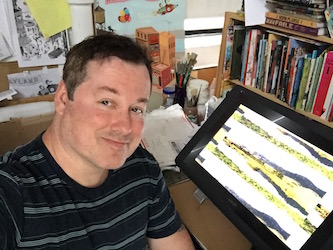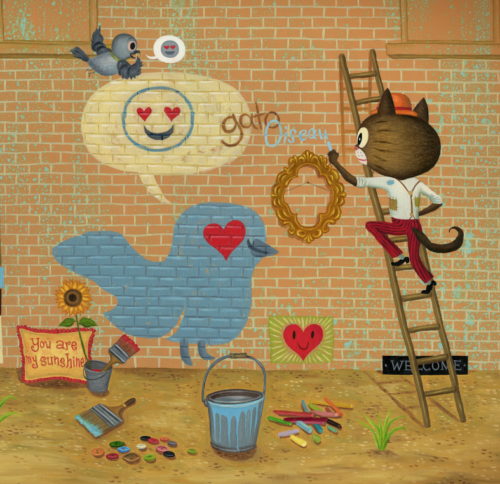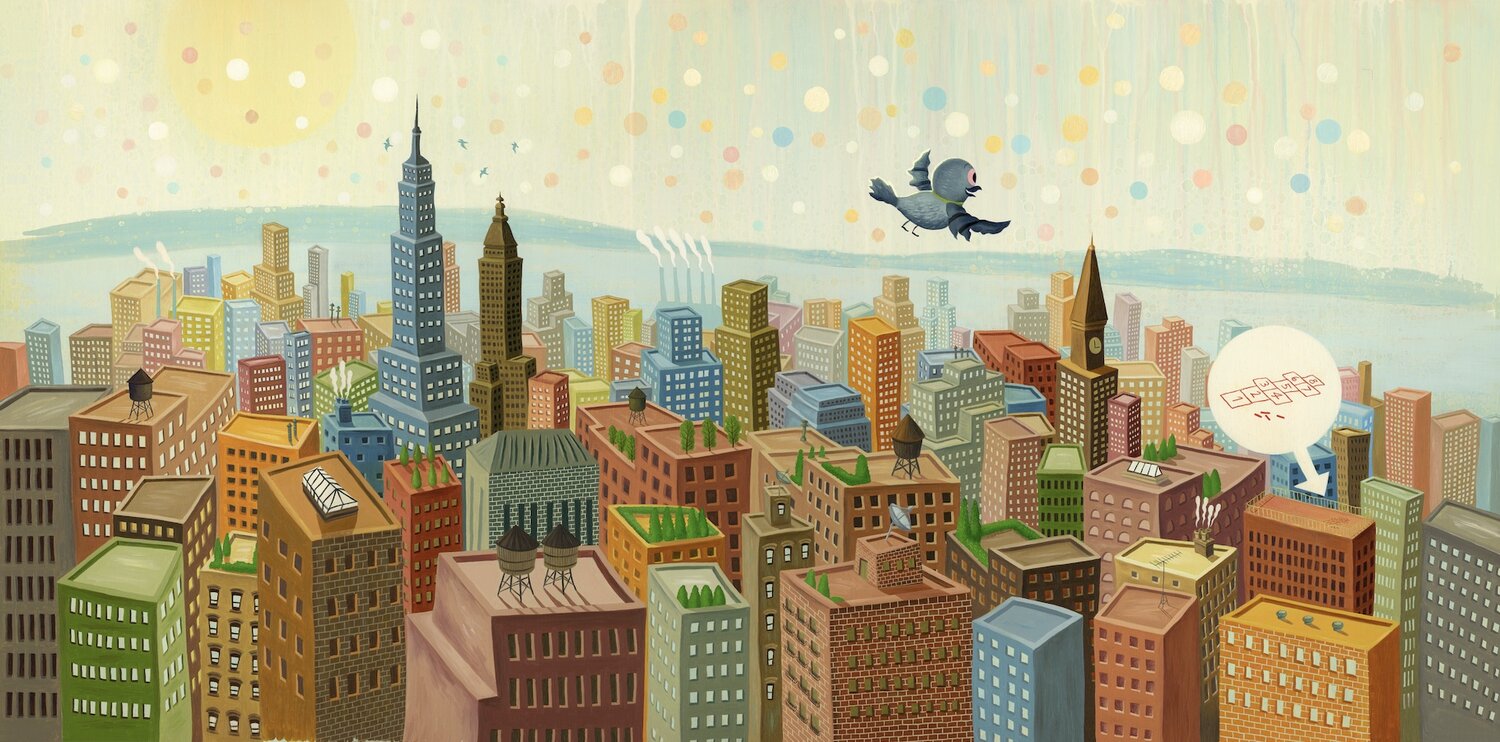Pigeon & Cat: An Interview with Eddie Hemingway

Folks, I’ve been in this business a while. I see picture book creators come and I see picture book creators go. Of the creators that have stuck around, the only ones I’m really capable of remembering are the artists with a distinctive style. The ones that look like nobody else. Eddie Hemingway? He fits that mold.
Edward Hemingway? This guy’s good people. As his bio reads, “Edward Hemingway is the author-illustrator of the picture books Bad Apple: A Tale of Friendship and Bad Apple’s Perfect Day, and the illustrator of two popular adult books, Of All the Gin Joints and Hemingway & Bailey’s Bartending Guide to Great American Writers. A grandson of Ernest Hemingway, he is originally from Bozeman, Montana and now lives and works in Brooklyn.”
ADVERTISEMENT
ADVERTISEMENT
I’ve admired Eddie’s work for years. Way back in 2008 I reviewed his picture book Bump in the Night saying it was, “an old-fashioned concept wrapped in a visual treat.” Eddie’s newest book, out June 21st, is Pigeon & Cat. A marvelous retro-styled treat of friendship, it’s illustrated in an underground comix style with this plot (coming to you via the publisher):
“In an abandoned city lot, Cat lives alone in a cardboard box. He leaves only to find food. One day, Cat discovers an unbroken egg too beautiful to eat. Soon, out pecks Pigeon, and they become fast friends. Cat is happy to share his box with Pigeon. But when Pigeon flies far away from where they live, Cat must brave the city in order to rescue his friend. This journey will forever transform his understanding of home.”
I had a chance to talk to Eddie about his latest and where it came from.
Betsy Bird: Eddie! It’s been too long! How positively delightful to see that you’ve a new book out. And a bird related one as well! I wholly approve. How did Pigeon & Cat come about?
Eddie Hemingway: Betsy! Hello! It has been too long. I too am delighted to be in touch!

The idea for Pigeon & Cat came to me when I was living in Red Hook, Brooklyn over a decade ago. On my frequent walks in the neighborhood, I became aware of all the feral cats that lived in the empty lots along the avenue. The cats were very cute, and I would often approach them, but they would always hiss and run away as soon as they saw me coming. I wondered what it would take to win them over. Then hurricane Sandy hit in 2012, and I had to move out of my flooded neighborhood. Safe and warm in a new location, I often thought about those cats. Did they weather the storm or move deeper into the borough? I had imagined that they had stayed put, cautiously rooted to the only place they’d ever known. I could relate to that. I hadn’t wanted to move after Sandy, but being forced into a new neighborhood turned out to be a very positive and constructive change for me. Since then I’ve wanted to write a book about my time before and after Sandy. A book about leaving a safe space to inhabit a larger one filled with uncertainty. A book about winning over one of those wild feral strays in Red Hook and showing them there’s new life after a rough storm-so maybe then they’d let down their guard and welcome anyone who’d attempt to cross their path.
BB: Aww. I remember Sandy. So let’s look at bit closer at your art here. Sometimes, for fun, I’ll look through how professional reviewers have identified your incredibly singular style in the past. I see that they’ve called it a “quirky retro-style”, amongst other things. How would you yourself describe your style. And are there any underground comic influences there at all?
EH: Absolutely. I’ve always loved comics. As a kid I read all the superhero comics I could get my hands on (mainly stolen from my older brothers’ extensive stash), and then I discovered Edward Gorey’s Amphigorey. It became my bible. His morbid humor and unique line drawings captivated me, and opened my eyes to the larger world of alternative comics and storytelling. I soon discovered Art Spiegelman, Kim Deitch, Wendy and Richard Pini, and later Jason, to name just a few. As I got older I’ve also been very inspired by contemporary artists like Gary Baseman, Wes Lang, Margaret Kilgallen, the Clayton Brothers, and Georganne Dean.

How would I describe my style? That’s such a great question. I actually feel lucky that my ability as a painter is so limited. Why? I’ve often told my students (when I taught creative writing at the graduate level at SVA) that one’s personal style is largely defined by one’s limitations. What I mean is that if we “lean into” and exploit the little quirks and constraints in our abilities, we often reveal unique and interesting “mistakes” that only we would make. I believe those mistakes actually can strengthen our personal and unique voice. In undergraduate art school (at RISD) I suppose I wanted to be an exquisite draftsman like early David Salle or any period Paul O. Zelinsky, but I just didn’t have their ability or skill. So I began to emphasize my “shortcomings”- my heavy hand, warped perspective, flat application of paint and odd color choices. I stopped trying to paint like people I admired and embraced my odd, quirky choices and obsessions- and thus began my journey towards finding and celebrating my personal style. It’s a journey that I’m still on. I want to tell stories and make images that are recognizable but that also invite people to see something familiar or ordinary in a slightly new and/or unique way. So the fact that you describe my style as “incredibly singular” is honestly the highest praise I can imagine. 🙂
BB: Well, and this book in particular is such a visual eye-popper. One minute you’re doing silhouettes and the next you’re incorporating emojis into Pigeon’s speech balloons. These cityscapes are also highly detailed. Quite frankly, this looks like it was a lot of fun to make but also a ton of work. Was that the case?
EH: Exactly the case. The book took me about three times as long to paint as any of my previous books, but it was a joy to create. It was especially surreal working on all those cityscapes filled with interacting characters when my life at the time was so solitary. I painted the book during the height of the Pandemic, so I was isolating in my studio or at home with my fiancé. In a way, the book became one of my friends, and I looked forward to seeing it and working on it every day.

I also knew when I started the finished artwork for “Pigeon & Cat” that I wanted it to be full of warm earthy colors and different painterly textures and urban energy, so I experimented with dripping paint and creating new textures with sponges, rollers, and different brushes. And since I love cut paper, I made the silhouette images from hand cut black paper which I then adhered onto the painted panels. It never gets old experimenting and trying new things, and I’m so lucky to have a wonderful editor and art direction team at LBYR that encouraged me to indulge in my personal vision.
BB: It’s funny. What starts as a simple tale of helicopter parenting turns into a storyline of housing insecurity and how necessary it is, particularly in an urban setting, for us to take care of one another. What caused you to move the book in this direction?
ADVERTISEMENT
ADVERTISEMENT
EH: I don’t know about you, but the last several years have been very hard on me as an optimist. I see so much division and outrage in our culture everyday, and I guess I consciously wanted to create a book that celebrated our commonalities, our compassion, our community.
We are all capable of choosing to be kind, but it’s not always easy, especially in tough times. So I deliberately began Pigeon and Cat with one small act of kindness. When Cat finds Pigeon’s abandoned egg on the ground he protects it instead of eating it. This act not only changes the trajectory of both their lives, but of the community in which they live. Small acts of kindness can shine a bright light in dark times, and open the pathway to a positive future. This only sounds corny because it’s true.
BB: Aw. I wouldn’t say corny. Not at all. Final question then. Last but not least, what are you working on next?
EH: I’m working on a couple of proposals at the moment. The one I’m most excited about is a tongue in cheek/fabulist/historical fiction take on the first cat my grandfather, Ernest Hemingway, owned in Key West. His name was Snowball and he was a white haired polydactyl with six toes on his two front paws. He grew up on a boat and was given to my grandfather as a gift from the boat’s captain. I so love the idea of a cat needing to find his “land legs” after a life at sea… And in addition to all this, Snowball also sired all the cats on the Key West property, and his decedents now densely populate the Hemingway House and surrounding neighborhood. It feels like a fun tale that I was born to tell.

Big thanks to Eddie for taking the time to answer my questions! Thanks too to Victoria Stapleton for setting up this interview. Pigeon & Cat is available on bookshelves everywhere June 21st. Find it then!
Filed under: Interviews
About Betsy Bird
Betsy Bird is currently the Collection Development Manager of the Evanston Public Library system and a former Materials Specialist for New York Public Library. She has served on Newbery, written for Horn Book, and has done other lovely little things that she'd love to tell you about but that she's sure you'd find more interesting to hear of in person. Her opinions are her own and do not reflect those of EPL, SLJ, or any of the other acronyms you might be able to name. Follow her on Twitter: @fuseeight.
ADVERTISEMENT
ADVERTISEMENT
SLJ Blog Network
2024 Books from Pura Belpré Winners
Winnie-The-Pooh | Review
Parsing Religion in Public Schools
Crafting the Audacity, One Work at a Time, a guest post by author Brittany N. Williams
ADVERTISEMENT








I look forward to getting this book for my school library!
Thanks so much!